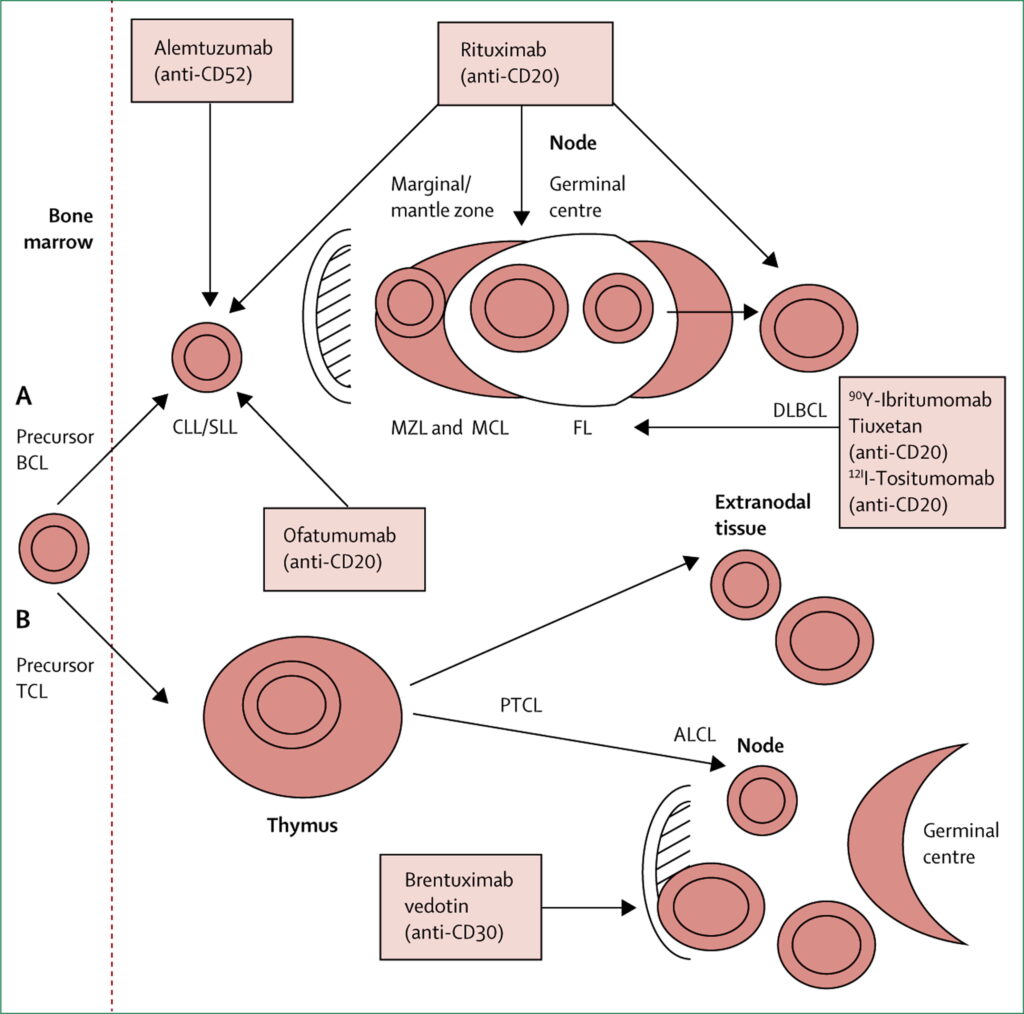CD20-positive non-Hodgkin’s lymphoma (NHL) is a subtype of B-cell lymphoma characterized by the expression of the CD20 protein on the surface of malignant cells. This condition encompasses various lymphoid malignancies, which differ in aggressiveness, prognosis, and response to treatment. Understanding its clinical features, diagnostic approaches, and treatment modalities is essential for effective disease management.

What is CD20?
CD20 is a membrane-bound protein expressed on the surface of B-cells during various stages of development, excluding stem cells and plasma cells. It plays a vital role in B-cell activation, proliferation, and calcium channel signaling. The overexpression of CD20 in certain B-cell malignancies makes it a valuable biomarker for diagnosis and a target for therapeutic interventions.
Types of CD20-Positive Non-Hodgkin’s Lymphoma
1. Diffuse Large B-Cell Lymphoma (DLBCL)
- Characteristics: Aggressive subtype with rapid progression if untreated.
- Prevalence: The most common NHL subtype worldwide.
- Treatment: Often involves immunochemotherapy, such as R-CHOP (rituximab, cyclophosphamide, doxorubicin, vincristine, and prednisone).
2. Follicular Lymphoma (FL)
- Characteristics: Indolent and slow-growing but can transform into a more aggressive form.
- Prevalence: Accounts for approximately 20% of NHL cases.
- Treatment: Watchful waiting for asymptomatic cases, with rituximab or obinutuzumab-based regimens used for symptomatic cases.
3. Mantle Cell Lymphoma (MCL)
- Characteristics: Intermediate behavior with features of both indolent and aggressive lymphomas.
- Prevalence: Represents 6% of all NHL cases.
- Treatment: High-dose chemotherapy, stem cell transplantation, and targeted therapies.
Diagnostic Approaches
Clinical Presentation
- Symptoms include persistent lymphadenopathy, fever, night sweats, unexplained weight loss, and fatigue.
- Extranodal involvement, such as in the gastrointestinal tract, skin, or central nervous system, may occur.
Laboratory and Imaging Studies
- Blood Tests: Complete blood count (CBC), lactate dehydrogenase (LDH) levels, and immunophenotyping.
- Imaging: PET-CT and CT scans for disease staging and monitoring.
Biopsy
- A definitive diagnosis requires histopathological examination of lymphoid tissue, often complemented by immunohistochemistry to detect CD20 expression.
Flow Cytometry
- Identifies CD20-positive B-cells using labeled antibodies.
Treatment Modalities
Immunotherapy
- Monoclonal Antibodies: Rituximab and obinutuzumab target CD20 and enhance immune-mediated cytotoxicity.
- Antibody-Drug Conjugates: Deliver cytotoxic agents directly to malignant cells expressing CD20.
Chemotherapy
- Standard regimens like R-CHOP are used for aggressive subtypes.
- Bendamustine-based therapies are effective for indolent forms.
Targeted Therapies
- BTK Inhibitors: Ibrutinib and acalabrutinib target B-cell receptor signaling pathways.
- PI3K Inhibitors: Idelalisib offers an option for relapsed or refractory cases.
Radiation Therapy
- Applied in localized disease or as part of palliative care.
Stem Cell Transplantation
- Autologous Transplant: High-dose chemotherapy followed by reinfusion of the patient’s own stem cells.
- Allogeneic Transplant: Donor stem cells are used, offering a potential cure but with a higher risk of complications.
Prognosis and Survival Rates
Prognosis depends on factors such as lymphoma subtype, stage at diagnosis, patient age, and response to initial treatment. The International Prognostic Index (IPI) is a commonly used tool for risk stratification. Five-year survival rates vary significantly:
Future Directions in Research
Novel Therapies
- Bispecific Antibodies: Target CD20 and T-cell markers to enhance anti-tumor activity.
- Chimeric Antigen Receptor (CAR) T-Cell Therapy: Engineered T-cells targeting CD20 show promising results in clinical trials.
Biomarker Studies
- Research aims to identify additional markers to predict treatment response and monitor disease progression.